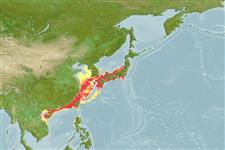>
Eupercaria/misc (Various families in series Eupercaria) >
Haemulidae (Grunts) > Plectorhinchinae
Etymology: Parapristipoma: Greek, para = the side of + Greek, pristis = saw + Greek, poma = operculum (Ref. 45335).
Environment: milieu / climate zone / depth range / distribution range
นิเวศวิทยา
เกี่ยวกับทะเล,น้ำเค็ม กลุ่มสัตว์หน้าดิน,กลุ่มสัตว์พื้นท้องน้ำ; สัตว์น้ำที่อาศัยและอพยพภายในทะเลเท่านั้น. Subtropical; 39°N - 15°N, 105°E - 140°E
Indo-West Pacific: southern Japan, East China Sea and Taiwan.
Length at first maturity / ขนาด / น้ำหนัก / Age
Maturity: Lm 18.0, range 16 - 20 cm
Max length : 40.0 cm SL เพศผู้/กระเทย; (Ref. 559); น้ำหนักสูงสุดที่มีการรายงาน: 1.1 kg (Ref. 40637)
Cultured and released for fishery in Japan. The species prefers relative warm water, high salinity, and rocky shores. The species does seasonal offshore-inshore migrations in limited areas (Ref. 34104).
Oviparous, distinct pairing during breeding (Ref. 205). A couple ascends quickly to the surface and spawns (Ref. 34104).
Masuda, H., K. Amaoka, C. Araga, T. Uyeno and T. Yoshino, 1984. The fishes of the Japanese Archipelago. Vol. 1. Tokai University Press, Tokyo, Japan. 437 p. (text). (Ref. 559)
IUCN Red List Status (Ref. 130435: Version 2024-2)
Threat to humans
Harmless
Human uses
การประมง: การค้า; การตกปลาเป็นกีฬา: ใช่
เครื่องมือ
Special reports
Download XML
แหล่งที่มาจากอินเตอร์เน็ต
Estimates based on models
Preferred temperature (Ref.
123201): 18.2 - 26.6, mean 24.1 °C (based on 168 cells).
Phylogenetic diversity index (Ref.
82804): PD
50 = 0.5625 [Uniqueness, from 0.5 = low to 2.0 = high].
Bayesian length-weight: a=0.00933 (0.00558 - 0.01561), b=3.01 (2.86 - 3.16), in cm total length, based on LWR estimates for this species & (Sub)family-body (Ref.
93245).
ระดับชั้นอาหาร (Ref.
69278): 3.4 ±0.45 se; based on food items.
ความสามารถในการกลับคืนสู่ปกติ (Ref.
120179): ขนาดกลาง, เวลาต่ำสุดที่จะทำให้ประชากรเพิ่มขึ้นเป็น 2 เท่าใช้เวลา 1.4 - 4.4 ปี (K=0.25-0.35; tm=2; Fec=30,083).
Fishing Vulnerability (Ref.
59153): Moderate vulnerability (36 of 100).
Nutrients (Ref.
124155): Calcium = 63.2 [13.8, 129.8] mg/100g; Iron = 0.987 [0.507, 1.843] mg/100g; Protein = 18.4 [16.5, 20.2] %; Omega3 = 0.33 [0.16, 0.59] g/100g; Selenium = 27.9 [14.4, 54.5] μg/100g; VitaminA = 28.1 [10.6, 75.8] μg/100g; Zinc = 0.795 [0.567, 1.126] mg/100g (wet weight);
